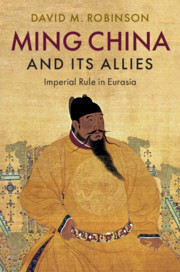Book contents
- Ming China and Its Allies
- Ming China and Its Allies
- Copyright page
- Dedication
- Contents
- Maps
- Acknowledgments
- Abbreviations
- Introduction
- 1 March to Power in a Chinggisid World
- 2 Search for Control
- 3 Mongol Nobles at the Ming Court
- 4 The Struggle for the Chinggisid Legacy
- 5 Allies and Commensurability
- Conclusion
- Bibliography
- Index
5 - Allies and Commensurability
Published online by Cambridge University Press: 10 December 2019
- Ming China and Its Allies
- Ming China and Its Allies
- Copyright page
- Dedication
- Contents
- Maps
- Acknowledgments
- Abbreviations
- Introduction
- 1 March to Power in a Chinggisid World
- 2 Search for Control
- 3 Mongol Nobles at the Ming Court
- 4 The Struggle for the Chinggisid Legacy
- 5 Allies and Commensurability
- Conclusion
- Bibliography
- Index
Summary
Chapter Five uses the Tumu crisis to shed light on two more facets of Ming rulership in east Eurasia. The first is the Ming court’s deep commitment to secure allegiance among neighboring elites, and the second is the striking commensurability between the Ming throne and Mongol (including Oirat) nobles. Both issues throw into relief contemporary awareness that Ming rulership did not occur in isolation but rather coexisted with other centers of power and authority. Ming rulers strove to shape the perceptions and actions of neighboring lords, great and small. Drawing on its military, economic, ritual, and rhetorical resources, the Ming court established itself as east Eurasia’s premier patron. The Oirats’ rise showed that the Ming court’s influence might be challenged, but in the mid-fifteenth century, no one – even Esen – seriously contemplated toppling, much less replacing, the Ming dynasty.
Keywords
- Type
- Chapter
- Information
- Ming China and its AlliesImperial Rule in Eurasia, pp. 163 - 195Publisher: Cambridge University PressPrint publication year: 2020

